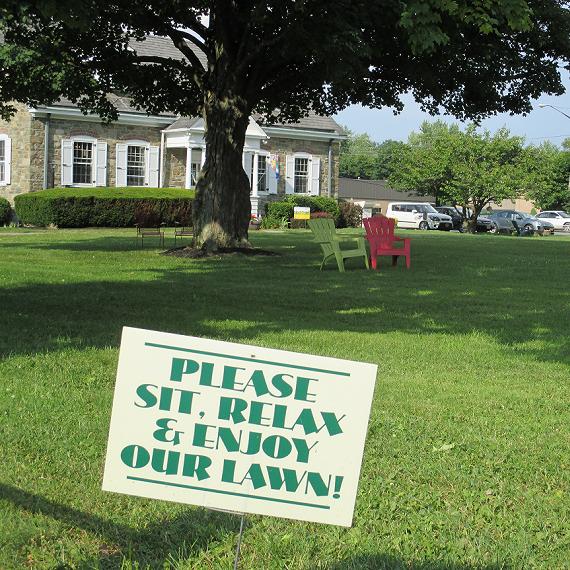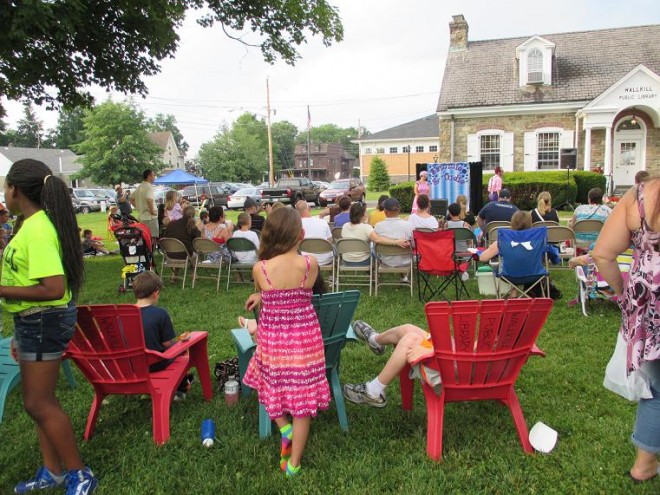A biweekly newsletter with public space news, resources, and opportunities.
A curated dispatch on all things public markets plus the latest announcements from the Market Cities Program.

In our Citizen Placemaker series, we chat with amazing and inspiring people from outside the architecture, planning, and government worlds (the more traditional haunts of Placemakers) whose work exemplifies how creating great places goes far beyond the physical spaces that make up our cities.
This month we chatted with Mary Lou Carolan, the director of the Wallkill Public Library and an inaugural member of the Placemaking Leadership Council (PLC). Mary Lou is working on a masters' program at Clarion University, and has been using what she's learning there to transform the library into a community hub. Following the PLC's meeting in Detroit, she was inspired to pull the action out onto the library's front lawn. The results, as you'll see, have been nothing short of inspiring.
You've been doing some interesting things at the library; can you tell us about your recent efforts to re-frame the front lawn as a public space?
We have a huge front lawn—about 30,000 square feet—and this small library way at the back of the property. It's hard to know what the building is unless you are familiar with the library already. The lawn is beautiful, and we use it several times a year for our children’s programs; it’s a great space, but when we didn’t have a program scheduled, people didn't really feel welcome to come in and sit down.
After the [PLC] workshop in Detroit, I really stood outside and looked at everything. I looked at the building from all different angles. A very obvious problem was that the property had concrete and metal pole fencing all around the perimeter, and people had to hop over the pole in order to get into the lawn. I thought, 'Why don’t we get rid of some of this fence?' We’re taught from an early age, if there’s a fence, you don’t go in unless you have permission. So we had a barrier we needed to get rid of, but we also needed to then give people permission to come in. That’s where the signs came from, that say “Please come sit and enjoy the front lawn.”
Then, these wonderful Adirondack chairs are all over the place now. I was talking about the idea of putting them out on the lawn with someone from our Friends of the Library group, and she said 'Well why don’t we just buy them?' So we got the chairs, we put them out on the front lawn, and it was like magic.

It sounds like there was really a lot of impact, for a pretty low-cost project.
We have ten or eleven chairs; they were about $15 a pop. The signs were $40 to have printed.We had a volunteer cut the metal poles out, so that didn’t cost us anything. It cost us less than $200. Today, it’s 95 degrees and humid out, and there are people all over the front lawn. There’s a grandma texting in the shade, moms sitting around chatting, and kids running all over. It was such a simple thing to do, and it really aligned with what PPS has been saying: just do it, don’t think of the money.
How has opening up the lawn affected the library more broadly? Are more people coming in?
This is actually our busiest time of year. We have 350 kids registered for our summer programs, so on any given day we have about 200 people walking in and out of our doors. Still, I think that opening up the front lawn to everybody has brought more people in—they get that sense of, 'Well, if I’m welcome on the front lawn, let me go check out what the library is all about.' As I always tell my staff: once they’re in the door, that’s your job, to keep them there, and to show them what we have to offer. It’s a couple-thousand square foot library; it's not big, but we’re hoppin’! Every square inch is utilized.
My whole personal philosophy, and the reason that I believe in what PPS is doing, is about building community. The library, and libraries in general throughout the country, are prime places for doing this. They’re often located in downtown areas, many of which are struggling. Libraries have the key qualities of an anchor store: re-visitation each week by families, children, seniors, all sorts of people. We’ve got that ‘customer base,’ basically. We’re always working with our downtown businesses, to try to help them. We’re saying: the people are here, give us your coupons, give us gift certificates, things like that. We’ll get the people to come over to you.
This is very much in line with what we’ve seen over the past decade or so, where there’s been a shift in how libraries are thought of. The old paradigm of the mean, shushing librarian is gone; now it’s the complete opposite, with libraries trying to be some of the most vibrant places. Can you talk about that trend a bit?
In libraries, the paradigm has shifted. Information, which is our business, has changed profoundly, in terms of how it’s delivered. It’s changed so rapidly, and I’m really proud of libraries for staying on top of things. I think we have a tough reputation to try and shake—that shushing librarian is a strong character in a lot of people's minds! Even today, when parents of young kids come in, the minute they’re inside they tell their kids 'Shh, you’re in the library.' All of my staff has been instructed to say 'This is a non-shushing library. Go ahead and talk. Have fun, and welcome.' We do that pitch right off the bat, and it doesn’t take long for people to start to feel comfortable.
So much of what we’re doing now is re-educating people, to change their perception of the library and welcome the library into their lives in a new and different way. In Wallkill, we’ve done that through a heavy dose of programming. We’re great believers in programming. We have entertainment, educational programs, musical programs, cooking programs. We get people together and bring them into the library so that they can learn. That’s ultimately what we’re about. We really want to get people together. What other place in town can you go where you don’t have to buy anything? You don’t have to be affiliated with a particular group to be here, you don’t have to pay a membership, you don’t even need a library card to hang out here.
Another thing that's happening—and it’s something we’re going to try out in this library next year—is that many libraries are becoming maker spaces, providing opportunities where people can gather and create. They’re using 3D printers, they’re employing people to come and show how, say, a computer works, and how to take it apart and put it back together again. They’re forming these wonderful places of invention and creativity. It’s almost like libraries are going back to how they began: as gathering spaces for people to talk about ideas, and shaping new concepts. It is a paradigm shift from how things have been recently, but it’s almost really like going back to basics.

One of the major themes at the Detroit meeting was the discussion of governance, and how it can be re-oriented toward place. Libraries are public institutions; are there wider lessons that we can take about governance from what libraries are doing?
Absolutely. One of the things that I think is so wonderful about libraries is that we’re the premier collaborators and resource-sharers. We’re not territorial. A great example is the library system. Here we are, a small rural library with limited shelf space; but because we’re part of a larger system, your card gets you access to materials from 47 other libraries. I think what the town and other institutions can learn from libraries is how to work together to maximize available funding, and share resources. When they go to do something, anything—pass a law, start a program, open something up to the community—they need to think: who else needs to know about this? That will reduce a lot of waste and duplication, and it builds community.
What's next for the Wallkill Public Library's Placemaking efforts?
One thing we’re going to be doing—and this is a direct link, again, to the PLC meeting in Detroit—I’m working to organize four Placemaking workshops. I’m going to invite specific people, because I want them to know about it, but I’m planning to open them up to the whole community: parents, library users, non-users, whomever. Our community needs help; we need to develop, grow, and work together. I want to establish this, first of all: who are we, as a town? Let’s figure that out as a community. What are our assets? What can we expand upon? I don’t want to focus on the negatives, or the lack of money. There’s plenty of that. I want us to talk about and focus on the things we can do, and to not have limiting thoughts but just imagine what’s possible.
Then, we need to ask ourselves, what are some things that we can do, now? It’s funny...we’ve used the library the last couple of years as kind of an incubator for this, and putting the chairs on the lawn was really the culmination. We’ve been doing this bit by bit, and our programs have been growing, and people have been saying ‘wow, you’re doing these great things at the library, and now I drove past the library, and there were all of these people on the lawn!’
People need help thinking about these things, you know? But once you get them going and ignite that spark, they get it; they know what they like. They might not be able to articulate exactly what it is, but they know the feeling. That was talked about a lot in Detroit: you walk into certain places and you just feel good; you feel welcome. I want to know why. I want people to really ask, ‘why is that,' and then to pull those things out, and look at ways to make more of that happen. It’s really going back to basics, gathering people together, and starting a conversation.
The rich text element allows you to create and format headings, paragraphs, blockquotes, images, and video all in one place instead of having to add and format them individually. Just double-click and easily create content.
The rich text element allows you to create and format headings, paragraphs, blockquotes, images, and video all in one place instead of having to add and format them individually. Just double-click and easily create content.
Body Text Body Link
The rich text element allows you to create and format headings, paragraphs, blockquotes, images, and video all in one place instead of having to add and format them individually. Just double-click and easily create content.
Here is some highlighted text from the article.




Headings, paragraphs, blockquotes, figures, images, and figure captions can all be styled after a class is added to the rich text element using the "When inside of" nested selector system.
Headings, paragraphs, blockquotes, figures, images, and figure captions can all be styled after a class is added to the rich text element using the "When inside of" nested selector system.
Headings, paragraphs, blockquotes, figures, images, and figure captions can all be styled after a class is added to the rich text element using the "When inside of" nested selector system.